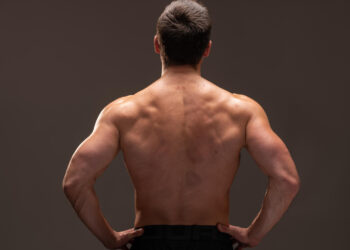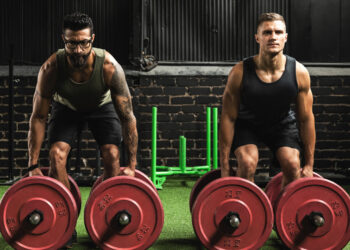The one-arm bench dip is a more advanced variation of the same exercise where both arms work together to perform the movement. It’s also a better option for those who lack the upper body strength to perform a full bodyweight dip.
Dips are a classic exercise that when done correctly can be a safe and effective way to build bigger and stronger triceps muscles.
Learn how to do the one-arm dip in this exercise guide.
How To Do The One-Arm Bench Dip
Bench dips can place a lot of stress on the shoulders if done incorrectly. Learn how to do the one-arm variation safely and effectively with detailed step-by-step instructions below.
- Sit down on a bench, chair, or similar object and place both palms on the edge of the seat about shoulder width apart with the hands turned slightly outward away from the body at a roughly 45-degree angle.
- With the arms slightly bent or fully extended, scoot forward until your butt hangs just off the edge of the seat, keeping your knees bent and feet flat on the floor.
- Pull your shoulders back and down then lift your left arm and right leg up, and extend them out in front of you. This will require a little balance.
- Lean slightly back, then bend your right elbow and slowly lower yourself down until the upper arm is just above parallel to the floor. Your butt should drop straight down past the seat, remaining as close to it as possible.
- Push yourself up with the right arm until it’s fully extended. Squeeze your triceps muscle for a two-count and repeat for the desired number of repetitions.
- Switch arms and repeat by lifting your right arm and left leg. This is considered one set.
Important form tips
- Avoid descending too far down to where the upper arms are below parallel to the floor as this can place a lot of stress on the shoulders. It’s also just as important to keep your body as close to the bench as possible.
- Keep your shoulder blades pulled down and back. Do not allow them to roll forward as this will create more stress on the ball and socket joint. Lean slightly back into the movement for a safer shoulder position.
- Plant both feet on the floor if balance is an issue.
One-Arm Dip Benefits
Let’s talk about some of the benefits you can expect from incorporating the one-arm dip in your workouts.
Stronger and more muscular triceps
Unilateral bodyweight exercises are more challenging than their bilateral (working both sides simultaneously) counterparts because it’s harder to lift the same amount of weight using one limb at a time. This translates to greater gains in strength and muscle size.
Level Up Your Fitness: Join our 💪 strong community in Fitness Volt Newsletter. Get daily inspiration, expert-backed workouts, nutrition tips, the latest in strength sports, and the support you need to reach your goals. Subscribe for free!
Improve shoulder stability
The shoulder joint is more prone to injury because of its large range of motion and lack of stability compared to other body parts. Dips can be bad for the shoulders if done incorrectly. However, when used with proper care, they can help to strengthen the shoulder and increase stability in the joint.
The key is to not come too far down during dips.
Identify and correct strength strength imbalance
Training two limbs individually is one of the best methods for identifying and correcting left to right side muscle imbalances. A lack of muscular symmetry can throw off your training progress, and make you more susceptible to injuries.
An easy way to progress
Bodyweight exercises can eventually become too easy the more advanced you get in your training. There are many variations you can do to make an exercise more challenging including training one side at a time.
Variations and Alternatives
The one-arm bench dip can be a useful triceps exercise. However, these variations and alternatives have their advantages.
Two-arm bench dip
The two-arm bench dip is a great triceps exercise for beginners when done correctly because both arms support your body weight, giving you more control over the movement. You should be proficient at this variation before progressing to the single-arm bench dip.
One-arm sideways bench dip
The advantage of doing unilateral bench dips is you can position yourself sideways to a bench or chair and place your arm in a more comfortable and better shoulder position next to your body rather than behind. Keep your feet underneath in a shoulder width stance.
Machine dips
Machine dips are a great triceps exercise period. They allow you to more easily adjust the resistance and place your shoulders in a safer and more comfortable position. You can also perform this exercise using one arm at a time.
Level Up Your Fitness: Join our 💪 strong community in Fitness Volt Newsletter. Get daily inspiration, expert-backed workouts, nutrition tips, the latest in strength sports, and the support you need to reach your goals. Subscribe for free!
Note: There are many different machines that can be used for this variation.
Muscles Involved In The One-Arm Dip
Below we’ve included brief descriptions of the muscles involved in the one-arm dip.
Triceps brachii
The triceps brachii or triceps are the muscles on the back of the upper arm formed by a long, medial and lateral head that work together to extend the elbow, while the long head also plays a role in shoulder extension (bringing the arm back behind the body). Dips are one of the best exercises to build all three heads of the triceps muscles.
Deltoid Anterior
The deltoid anterior is one of the three heads that make up the deltoid or shoulder muscles. It helps to flex the arm forward at the glenohumeral (shoulder) joint and assists in stabilizing the arm during shoulder various shoulder actions (e.g., lifting the arm out to the side).
Latissimus Dorsi
The latissimus dorsi or lats for short is a broad, flat muscle that spans the lower posterior thorax. It works with the teres major and pectoralis major to adduct and medially rotate the humerus, and it helps to extend the humerus with help from the teres major and the sternal head of pectoralis major. The lats are also involved in moving the trunk forward and upward when the arms are positioned overhead.
Levator Scapulae
The levator scapulae is a superficial muscle located on the upper back. This muscle functions to elevate the scapula or shoulder blades with help from the trapezius and rhomboid muscles of the upper back. Surrounding muscles also help the levator scapulae to inferiorly rotate the scapula.
It also assists in movements such as neck extension, ipsilateral rotation, and lateral flexion.
Pectoralis Major Clavicular Head
The clavicular head of the pectoralis or major chest muscle is located on the upper portion of the chest near the clavicle area. It causes flexion of the extended arm.
Pectoralis Major Sternal Head
Also known as the lower chest, the pectoralis sternal head is a separate section of muscle fibers that assist in pulling the arms downward.
Quadriceps
The quadriceps or quads for short is the large muscle group on the anterior upper leg that has four heads; rectus femoris, vastus lateralis, vastus medialis, and vastus intermedialis. These muscles help to flex the hips and extend the knees during movements such as squats. They’re also important for posture, walking, and function of the spine and pelvis.
The quads benefit from isometric tension during bench dips.
Wrapping Up
The one-arm dip is a great way to mix up your arm training and improve your triceps muscle development. It’s more challenging than the basic variation, and is therefore better suited for those with more training experience and healthy shoulders.
Interested in measuring your progress? Check out our strength standards for Bench Dips, Ring Dips, Squat, and more.








